Items filtered by date: July 2024
Understanding Plantar Fibromatosis and Ledderhose Disease
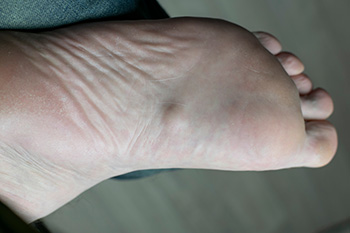
Plantar fibromatosis and Ledderhose disease are related conditions characterized by the development of benign nodules or lumps in the connective tissue of the feet, affecting the plantar fascia and foot arch. These nodules, composed of fibrous tissue, can cause pain and discomfort, particularly while standing or walking. Plantar fibromatosis typically affects the middle of the foot's underside, while Ledderhose disease occurs on the underside of the foot arch. These conditions often cause a feeling of pressure or a sensation akin to walking on pebbles. While symptoms can vary, they generally worsen with weight-bearing activities due to the increased pressure on the affected areas. Relief options include orthotic devices, steroid injections, and in severe cases, surgical removal of the nodules to alleviate pain and restore foot function. If you have nodules or lumps on the bottom of your foot, it is suggested that you consult a podiatrist who can accurately diagnose and treat these conditions.
A plantar fibroma may disrupt your daily activities. If you have any concerns, contact Dr. Douglas Mckay of New Jersey . Our doctor can provide the care you need to keep you pain-free and on your feet.
Plantar Fibroma
A plantar fibroma is a fibrous knot in the arch of the foot. It is embedded in the plantar fascia which is a band of tissue that extends from the heel to the toes along the bottom of the foot. There can be multiple plantar fibromas in the feet at the same time. There are no known causes for this condition. If you have a plantar fibroma, there will be a bump in the arch of your foot that cannot be missed. Any associated pain is most often due to a shoe rubbing against the nodule. Non-surgical options, such as steroid injections, physical therapy, and orthotics should be tried first. Surgery is a last resort and is the only thing that will remove a plantar fibroma entirely. Consult with a podiatrist for a proper diagnosis and to determine the treatment regimen that is right for you.
What Causes a Plantar Fibroma?
While there are no specific causes identified, a plantar fibroma can possibly come from genetic predisposition or the formation of scar tissue that forms from healing the tears in the plantar fascia.
What Are the Symptoms of a Plantar Fibroma?
There will be a noticeable lump in the arch of the foot that may or may not cause pain. If pain is felt, it is typically because a shoe is rubbing up against the lump or when walking or standing barefoot.
Treatment and Prevention
A plantar fibroma will not disappear without treatment, but it can get smaller and be a non-issue. If pain persists, a podiatrist examines the foot and when the arch of the foot is pressed, pain can be felt down to the toes. An MRI or biopsy might be performed to help diagnose or evaluate the plantar fibroma. The following non-surgical options are generally enough to reduce the size and pain of these nodules:
- Steroid injections
- Orthotics
- Physical therapy to help apply anti-inflammatory creams on the bump
Surgery is considered if the mass increases in size and the patient continues to feel pain after non-surgical methods are tried.
If you have any questions please feel free to contact one of our offices located in Caldwell, and Galloway, NJ . We offer the newest diagnostic tools and technology to treat your foot and ankle needs.
The Importance of Safe Footwear at Work
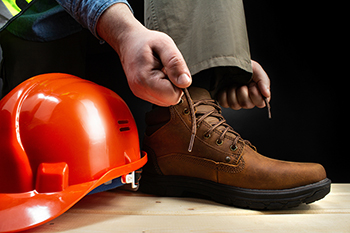
Wearing safe footwear at work is vital for preventing various foot conditions and ensuring overall health and safety. Wearing ill-fitting or inappropriate shoes can lead to issues such as blisters, calluses, and bunions, causing discomfort and affecting productivity. More serious conditions can include plantar fasciitis, which results from inadequate arch support, and metatarsalgia, caused by excessive pressure on the ball of the foot. Additionally, workplace hazards like heavy objects or slippery surfaces increase the risk of injuries like fractures or sprains without proper footwear. Choosing shoes with adequate support, cushioning, and non-slip soles can prevent these problems. Investing in the right footwear enhances comfort, reduces fatigue, and minimizes the risk of chronic foot conditions and acute injuries, ensuring a safer and more productive work environment. If you have had one or more foot injuries from wearing the wrong shoes while at work, it is suggested that you confer with a podiatrist who can treat various foot conditions and educate you on appropriate shoes for your workday.
While working on the feet, it is important to take the proper care of them. For more information about working on your feet, contact Dr. Douglas Mckay from New Jersey . Our doctor will treat your foot and ankle needs.
Working on Your Feet
Standing on your feet for long periods of time can cause stress and pain in your feet. Your whole body may experience change in terms of posture, back pain, bunions, callouses and or plantar warts. There are ways to avoid these conditions with proper foot care, smart choices and correct posture.
Positive Changes
Negative heeled shoe – Choosing this shoe type places the heel slightly lower than the ball of the foot. These are great for overall foot health. Find shoes that fit you correctly.
Go barefoot – Our feet were not designed to be enclosed for all hours of the day. Try to periodically expose your feet to air.
Eliminate Pain
Foot Exercises – Performing simple exercises, incorporating yoga and doing stretches are beneficial. This will allow increased blood flow to the area and muscles of the foot.
Achilles tendon – Stretching the foot out flat on the floor will relax the calf muscles and tendon. These exercises can be performed almost anywhere. Make sure you add these exercises to your daily regimen.
With a little bit of this information and knowing more about foot health, you will notice changes. Foot stretches and proper footwear will help with pain and prevent further issues.
If you have any questions please feel free to contact one of our offices located in Caldwell, and Galloway, NJ . We offer the newest diagnostic and treatment technologies for all your foot and ankle needs.
Various Types of Running Shoes
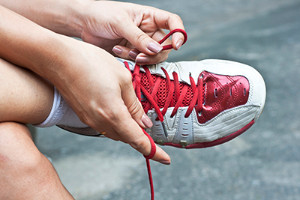
Running shoes come in various designs, each tailored for specific activities and impacting how feet hit the ground. Racing flats are lightweight and designed for speed, offering minimal cushioning to promote a natural, efficient stride. They allow runners to feel the ground more closely, encouraging a forefoot or midfoot strike. Distance spikes, on the other hand, feature spikes on the outsole for enhanced traction on track surfaces. These shoes are also lightweight but provide slightly more support than racing flats, helping runners maintain speed over longer distances. The spikes encourage a forefoot strike, maximizing propulsion and grip. Understanding these differences is vital for selecting the right shoe for your running goals, whether it is achieving maximum speed in a race or maintaining performance over a longer distance. Many people wear the wrong shoes for their style of running, and can endure foot injuries. If this applies to you, it is suggested that you consult a podiatrist who can treat any foot condition and educate you on what type of running shoes to wear.
You should always make sure your running shoes fit properly in order to avoid injury. For more information, contact Dr. Douglas Mckay from New Jersey . Our doctor can provide the care you need to keep you pain-free and on your feet.
Choosing the Right Running Shoe for Your Foot Type
Improper shoe sizing can cause a myriad of problems for your feet. Shoes that don’t fit you properly can lead to muscular imbalances in your body, which can result in foot, knee, and hip injuries.
Tips for Finding the Right Running Shoe
- Make sure you have a thumb’s width of wiggle room between the end of your longest toe and the front of the shoe.
- There should be little to no slipping at the heel
- Don’t assume your size in one shoe brand will be your size in another
- Do not lace up your shoes too tightly
- Walk around in the store with your new shoes before you buy them
If you have any questions please feel free to contact our one of our offices located in Caldwell, and Galloway, NJ . We offer the newest diagnostic and treatment technologies for all your foot and ankle needs.
Cracked Heels and Diabetes
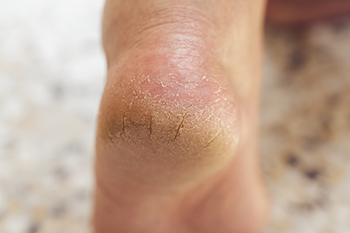 Diabetes, a chronic condition marked by high blood sugar levels, can significantly affect foot health, leading to complications such as cracked heels. Diabetes impairs circulation and causes neuropathy, which reduces sensation in the feet. This lack of sensation makes it harder to notice dry skin and small cracks, allowing them to worsen unnoticed. Cracked heels occur when the skin surrounding the heels becomes dry and thickens, leading to fissures that can be painful and prone to infection. Poor blood circulation in diabetic patients further hampers the healing process, increasing the risk of complications. To prevent and treat cracked heels, maintain proper foot hygiene and moisturize daily, focusing on the heels. Avoid soaking feet too long, as this can dry out the skin further. Wear supportive, well-fitting shoes to reduce pressure on the heels, and regularly inspect feet for cracks or sores. For persistent or severe cases of cracked heels, it is suggested that you seek the counsel of a podiatrist who can provide specialized care and recommend appropriate treatments.
Diabetes, a chronic condition marked by high blood sugar levels, can significantly affect foot health, leading to complications such as cracked heels. Diabetes impairs circulation and causes neuropathy, which reduces sensation in the feet. This lack of sensation makes it harder to notice dry skin and small cracks, allowing them to worsen unnoticed. Cracked heels occur when the skin surrounding the heels becomes dry and thickens, leading to fissures that can be painful and prone to infection. Poor blood circulation in diabetic patients further hampers the healing process, increasing the risk of complications. To prevent and treat cracked heels, maintain proper foot hygiene and moisturize daily, focusing on the heels. Avoid soaking feet too long, as this can dry out the skin further. Wear supportive, well-fitting shoes to reduce pressure on the heels, and regularly inspect feet for cracks or sores. For persistent or severe cases of cracked heels, it is suggested that you seek the counsel of a podiatrist who can provide specialized care and recommend appropriate treatments.
If the skin on your feet starts to crack, you may want to see a podiatrist to find treatment. If you have any concerns, contact Dr. Douglas Mckay from New Jersey . Our doctor can provide the care you need to keep you pain-free and on your feet.
Cracked Heels
It is important to moisturize your cracked heels in order to prevent pain, bleeding, and infection. The reason cracked heels form is because the skin on the foot is too dry to support the immense pressure placed on them. When the foot expands, the dry skin on the foot begins to split.
Ways to Help Heal Them
- Invest in a good foot cream
- Try Using Petroleum Jelly
- Ease up on Soaps
- Drink Plenty of Water
Ways to Prevent Cracked Heels
- Moisturize After Showering
- Skip a Shower
- Keep Shower Water Lukewarm
- Don’t Scrub Your Feet
If you are unsure how to proceed in treating cracked heels, seek guidance from a podiatrist. Your doctor will help you with any questions or information you may need.
If you have any questions, please feel free to contact one of our offices located in Caldwell, and Galloway, NJ . We offer the newest diagnostic and treatment technologies for all your foot care needs.
Recognizing Common Symptoms of a Broken Foot
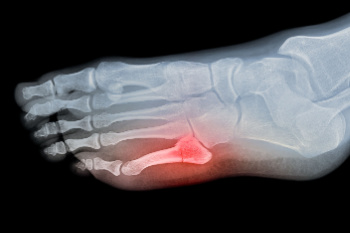
A broken foot can present with several clear symptoms, and it is vital to identify them for prompt treatment. One of the most telling signs is a sharp, severe pain that often worsens with movement or weight-bearing activities. A sensation of dislocated bones, where the foot feels misaligned or abnormal, is also common. Swelling and bruising typically develop rapidly around the affected area, indicating internal bleeding and inflammation. Visible deformities or an inability to move the foot or toes may also occur, in addition to a pronounced tenderness when touching the injured area. Treatment may include immobilization with a cast, use of crutches, and in severe cases, surgical intervention to realign the broken bones. If you feel you may have broken your foot, it is suggested that you consult a podiatrist who can accurately diagnose it and treat it accordingly.
A broken foot requires immediate medical attention and treatment. If you need your feet checked, contact Dr. Douglas Mckay from New Jersey . Our doctor can provide the care you need to keep you pain-free and on your feet.
Broken Foot Causes, Symptoms, and Treatment
A broken foot is caused by one of the bones in the foot typically breaking when bended, crushed, or stretched beyond its natural capabilities. Usually the location of the fracture indicates how the break occurred, whether it was through an object, fall, or any other type of injury.
Common Symptoms of Broken Feet:
- Bruising
- Pain
- Redness
- Swelling
- Blue in color
- Numbness
- Cold
- Misshapen
- Cuts
- Deformities
Those that suspect they have a broken foot shoot seek urgent medical attention where a medical professional could diagnose the severity.
Treatment for broken bones varies depending on the cause, severity and location. Some will require the use of splints, casts or crutches while others could even involve surgery to repair the broken bones. Personal care includes the use of ice and keeping the foot stabilized and elevated.
If you have any questions please feel free to contact one of our offices located in Caldwell, and Galloway, NJ . We offer the newest diagnostic and treatment technologies for all your foot and ankle needs.


